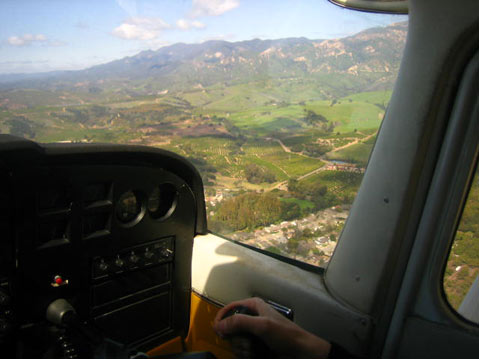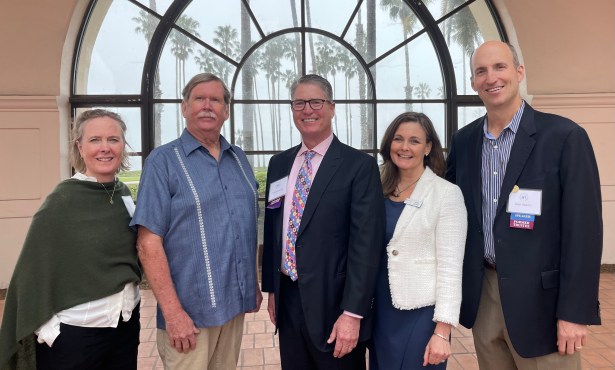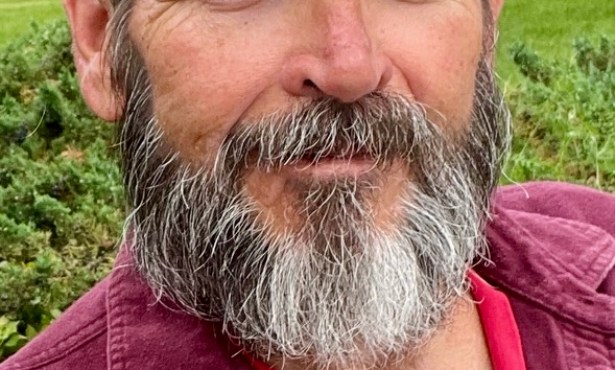Up, Up and Away—for 24 Minutes
Airport Flight School Offers Bargain View

“Pull the yoke back with your left hand and push the throttle forward with your right.” Andrea Read’s voice penetrated my headphones through the engine noise and, for a split second, I thought, “What yoke?”
Then I realized my instructor was talking about the U-shaped steering wheel in my left hand. I pulled it back while pushing in what resembled a manual choke I’d seen on old automobiles. The growl of the single engine went to bass. Underneath us, the runway blurred as the Cessna 172 taxied toward the sea, but its nose did not seem to lift.

“More throttle,” Read commanded. Almost effortlessly, the small plane suddenly broke free of gravity’s shackles, and the airport dropped away to reveal green fragments of the Goleta slough and a channel alive with waves of sun-cast diamonds.
Before I fully realized it, the Cessna was soaring like a pinstriped metal gull over the ocean and Read was in my ear again. “Let’s go down the coast to Santa Barbara.” Happy to cease squinting over the cowling and enjoy my new habitat, I slowly but firmly steered the aircraft left.
No sooner had I finished the turn and leveled off, setting a parallel path along the cloud-draped Santa Ynez mountains, than I felt the craft shudder and skip to the side; before I could react, the plane resumed its previous course. It was as if an invisible hand had given us a playful push. While traveling at 120 miles an hour.
“Yeah, the winds will do that up here,” Read said laconically. We were, I later learned, flying at around 3,000 feet. I never noticed the face of the altimeter, which tells the plane’s altitude, but then I barely scanned the dials on the control panel during my 24 minutes aloft. I was more interested in what I could see of the South Coast and the Santa Barbara Channel as we headed for the yacht harbor.
This perspective was why I paid $49 last month to take Spitfire Aviation’s “discovery flight” in the Cessna, which is what I told Read, the founder and owner of the flight school. While I easily took the plane off the ground, she landed it, which can be a lot trickier, and taxied it back to the hanger.
For would-be private pilots, she lets the experience at the controls speak for itself. If the hook grabs, Read will follow the introductory flight by discussing the training and licensing requirements of the Federal Aeronautics Administration (FAA). Spitfire’s website and brochure recommend 55-75 hours of combined ground and airborne training before taking the FAA exam. With the necessary books and manuals, plus a mandatory medical examination, the journey to that private license takes weeks and currently costs around $9,000, fuel surcharge not included.
Read, a UCSB graduate in sociology who has been flying since 1994, opened Spitfire Aviation Flight School at the Santa Barbara Airport in 1999 after becoming a certified instructor. She said she was one of the first women to open a flight school locally. Since she had been managing a restaurant until then her decision came as a big surprise to her family in British Columbia. “They thought I had gone nutzo,” she recalled with a laugh.
None of her immediate family flew, but Read knew that her grandmother’s brother flew a Spitfire in World War II. Though she never met “Uncle Ben” in person, she felt naming her company after his warplane was highly appropriate: It honored her family and its Canadian roots while conveying some of the adventure and mystique of flying a small but powerful airplane.
After her undergraduate years at UCSB, Read resisted the lure of flight until challenged by a restaurant coworker. Her first lessons out of Camarillo Airport were a revelation. Read had a woman instructor, “and after two or three flights—I’ll never forget it—I looked at her and said, ‘This is what I’m going to do for the rest of my life.’ I fell in love with it, though flying was hard for me.”
Read compared the initial year or two with falling in love because the experience is so physically, intellectually and emotionally involving. That is particularly true when a student pilot solos for the first time. “It’s so exciting. It’s an adrenaline rush, like being an athlete, combined with knowing that, perhaps for the first time, your life is literally in your own hands,” she declared.
With an estimated 13,000 hours of training and practice, Read’s role now is to teach people safe flying habits as well as how to fly. “I want to help them find their passion,” she added. Also, she said, the recession has made this small businesswoman recall how it was to overcome major hurdles.



